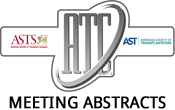2022 American Transplant Congress
National Attitudes Towards Early Liver Transplantation for Alcoholic Liver Disease
*Purpose: Pre-transplant abstinence requirements, notably the 6-month sobriety guideline, limit access to liver transplant for patients with severe alcoholic hepatitis (SAH). This study examines the…2022 American Transplant Congress
Phase I/ii Car-Treg Cell Therapy Clinical Trial To Induce Long-term Tolerance In Liver Transplant Patients
1King's College London, London, United Kingdom, 2Quell Therapeutics Ltd, London, United Kingdom
*Purpose: Life-long pharmacological immunosuppression (IS) is considered essential to prevent rejection following liver transplantation (LT), but is associated with significant side effects such as infections,…2022 American Transplant Congress
Experience Using Intra-Operative Dialysis in Surgically Complex Liver Transplantation
1Anesthesiology, Ochsner, New Orleans, LA, 2Surgery, Ochsner, New Orleans, LA
*Purpose: At our high-volume center, we often perform liver transplantation (LT) on surgically complex patients that includes re-transplantation, prior open liver resection, bariatric surgeries, extensive…2022 American Transplant Congress
A Intention-to-Treat Analysis of 881 Consecutively Waitlisted Patients to Develop a Survival Benefit Model for Hepatocellular Carcinoma Liver Transplant Candidates
*Purpose: The current liver transplantation (LT) selection paradigm for hepatocellular carcinoma (HCC) patients ignores the variable risks of waitlist dropout and post-LT recurrence/death, with the…2022 American Transplant Congress
Telemedicine Implementation in Solid Organ Transplant (SOT) Clinics is Associated with Satisfaction Among Patients and Providers but Increased Burden on Staff
University of California, San Francisco, San Francisco, CA
*Purpose: Telemedicine is an essential part of healthcare delivery and has grown exponentially during the COVID-19 pandemic. Data on optimal utilization and implementation of telemedicine…2022 American Transplant Congress
Ikaros-SIRT1 Signaling Axis Regulates Macrophage Pyroptosis and Ischemia-Reperfusion Injury (IRI) in Mouse and Human Liver Transplantation
1UCLA Medical Center, Los Angeles, CA, 2NIEHS, Durham, NC
*Purpose: Although Ikaros is a well-established regulator of lymphopoiesis, its role in myeloid cells and organ IRI remains unclear. We recently reported that the SIRT1-mediated…2022 American Transplant Congress
Temporal Changes in the Peripheral Immune Profile of Acute Rejection Highlight New Mechanisms of Alloimmunity and Potential Non-Invasive Biomarkers of Rejection in Pediatric Liver Transplantation
*Purpose: Acute rejection (AR) is common in pediatric liver transplantation (LT) and can impact late graft loss. Immune subpopulations mediating AR in LT have not…2022 American Transplant Congress
Revisiting Late Graft Loss or Death in Pediatric Liver Transplantation Through Analysis of the SPLIT Database
*Purpose: With advances in surgical techniques, medical management, and more equitable allocation systems, children who receive a liver transplant today can expect remarkable outcomes early…2022 American Transplant Congress
Reality Capture Using Light Detection and Ranging 3D Photography of Liver Grafts for Volumetric Assessment: A Proof-of-Concept Preliminary Study
*Purpose: Reality capture uses various technical means to capture a digital 3D model representation of a subject from the real world. Whole liver graft volume…2022 American Transplant Congress
Proteomic Profiling of Bile from Human Livers Undergoing Viability Assessment via Normothermic Machine Perfusion Prior to Transplantation
*Purpose: Normothermic machine perfusion (NMP) has gained increasing traction as a method to assess the viability of high-risk donor livers. To avoid post-transplant biliary complications,…
- « Previous Page
- 1
- …
- 12
- 13
- 14
- 15
- 16
- …
- 180
- Next Page »
